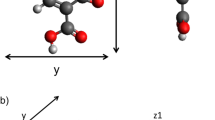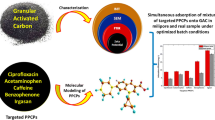Abstract
Three carbon samples were employed in this work, including commercial (1690 m2 g−1), activated carbon prepared from guava seeds (637 m2 g−1), and activated carbon prepared from avocado kernel (1068 m2 g−1), to study the adsorption of the following gadolinium-based contrast agents (GBCAs): gadoterate meglumine Dotarem®, gadopentetate dimeglumine Magnevist®, and gadoxetate disodium Primovist®. The activation conditions with H3PO4 were optimized using a Taguchi methodology to obtain mesoporous materials. The best removal efficiency by square meter in a batch system in aqueous solution and model urine was achieved by avocado kernel carbon, in which mesoporosity prevails over microporosity. The kinetic adsorption curves were described by a pseudo-second-order equation, and the adsorption isotherms in the concentration range 0.5–6 mM fit the Freundlich equation. The chemical characterization of the surfaces shows that materials with a greater amount of phenolic functional groups adsorb the GBCA better. Adsorption strongly depends on the pH due to the combination of the following factors: contrast agent protonated forms and carbon surface charge. The tested carbon samples were able to adsorb 70–90% of GBCA in aqueous solution and less in model urine. This research proposes a method for the elimination of GBCA from patient urine before its discharge into wastewater.








Similar content being viewed by others
References
Allen SJ, Mckay G, Porter JF (2004) Adsorption isotherm models for basic dye adsorption by peat in single and binary component systems. J Colloid Interface Sci 280:322–333
Alvares Rodrigues L, Caetano Pinto da Silva ML, Alvarez-Mendes MO, dos Reis Coutinho A, Patrocínio Thim G (2011) Phenol removal from aqueous solution by activated carbon produced from avocado kernel seeds. Chem Eng J 174:49–57
Bandosz TJ, Jagiello J, Contescu C, Schwarz JA (1993) Characterization of the surfaces of activated carbons in terms of their acidity constant distribution. Carbon 31:1193–1202
Barbosa-Martín E, Chel-Guerrero L, González-Mondragón E, Betancur-Ancona D (2016) Chemical and technological properties of avocado (Persea americana Mill.) seed fibrous residues. Food. Bioprod. Process 100:457–463
Benaddi H, Bandosz TJ, Jagiello J, Schwarz JA, Rouzaud JN, Legras D, Béguin F (2000) Surface functionality and porosity of activated carbons obtained from chemical activation of wood. Carbon 38:669–674
Benjamin MM, Leckie JO (1981) Conceptual model for metal-ligand-surface interactions during adsorption. Environ Sci Technol 15:1050–1057
Birka M, Wehe CA, Hachmöller O, Sperling M, Karst U (2016) Tracing gadolinium-based contrast agents from surface water to drinking water by means of speciation analysis. J Chromatogr A 1440:105–111
Birka M, Wehe CA, Telgmann L, Sperling M, Uwe K (2013) Sensitive quantification of gadolinium-based magnetic resonance imaging contrast agents in surface waters using hydrophilic interaction liquid chromatography and inductively coupled plasma sector field mass spectrometry. J Chromatogr A 1308:125–131
Birka M, Wentker KS, Lusmöller E, Arheilger B, Wehe CA, Sperling M, Stadler R, Karst U (2015) Diagnosis of nephrogenic systemic fibrosis by means of elemental Bioimaging and speciation analysis. Anal Chem 87:3321–3328
Brudey T, Largitte L, Jean-Marius C, Tant T, Couespel Dumesnil P, Lodewyckx P (2016) Adsorption of lead by chemically activated carbons from three lignocellulosic precursors. J Anal Appl Pyrol 120:450–463
Choppin GR, Schaab KM (1996) Lanthanide (III) complexation with ligands as possible contrast enhancing agents for MRI. Inorg Chim Acta 252:299–310
Clugstone M, Flemming R (2000) Advanced chemistry. Oxford University Press, Oxford
Cox BG (2013) Acids and bases: solvent effects on acid-base strenght. Oxford University Press, Oxford
Cyris M 2013: Behavior of gadolinium-based diagnostics in water treatment, University of Duisburg-Essen, Essen, DE., 171 pp
Dávila-Jiménez MM, Elizalde-González MP, García-Díaz E, González-Perea M, Guevara-Villa MRG (2014) Using Akaike information criterion to select the optimal isotherm equation for adsorption from solution. Adsorpt Sci Technol 32:605–622
Dávila-Jiménez MM, Elizalde-González MP, García-Díaz E, Marín-Cevada V, Zequineli-Pérez J (2015) Photodegradation of the anthraquinonic dye acid green 25 by TiO2 immobilized on carbonized avocado kernels: intermediates and toxicity. Appl Catal B-Environ 166-167:241–250
Elizalde González MP, Dávila Jiménez MM, Ornelas Dávila O (2011): Proceso para obtener un adsorbente a partir de un material de desecho y uso del adsorbente. Pat. ES2356765, 9 diciembre 2011.
Elizalde González MP, Dávila Jiménez MM, Ornelas Dávila O (2013): Process for obtaining an adsorbent from a waste material and use of the adsorbent. Pat. US 8,501,663 B2, August 6, 2013
Elizalde González MP, Dávila Jiménez MM, Ornelas Dávila O (2014): Proceso para obtener un adsorbente a partir de un Material de desecho y uso del adsorbente. Pat. MX320379, 21 Mayo 2014
Elizalde González MP, Dávila Jiménez MM, Ornelas Dávila O (2015): Process for obtaining an adsorbent from avocado waste and use of the adsorbent. Pat. US 9,174,857B2. November 3, 2015
Elizalde-González MP, García-Díaz LE (2010) Application of a Taguchi L16 orthogonal array for optimizing the removal of acid Orange 8 using carbon with a low specific surface area. Chem Eng J 163:55–61
Elizalde-González MP, Hernández-Montoya V (2009) Guava seed as an adsorbent and as a precursor of carbon for the adsorption of acid dyes. Bioresourse Technol 100:2111–2117
Elizalde-González MP, Mattusch J, Peláez-Cid AA, Wennrich R (2007) Characterization of adsorbent materials prepared from avocado kernel seeds: natural, activated and carbonized forms. J Anal Appl Pyrolysis 78:185–193
FAO (2003): Medium-term prospects for agricultural commodities. Proyections to the year 2010. In: Department EaSD (Hrsg.). FAO Corporate Document Repository. Publishing Management Service, Rome, Italy
Faria PCC, Órfão JJM, Pereira MFR (2004) Adsorption of anionic and cationic dyes on activated carbons with different surface chemistries. Water Res 38:2043–2052
Foo KY, Hameed BH (2010) Insights into the modeling of adsorption isotherm systems. Chem Eng J 156:2–10
Fuente E, Menéndez JA, Díez MA, Suárez D, Montes-Morán MA (2003) Infrared spectroscopy of carbon materials: a quantum chemical study of model compounds. J Phys Chem B 107:6350–6359
Giles CH, MacEwan TH, Nakwa SN, Smith D (1960): Studies in adsorption. Part XI. A system of classification of solution adsorption isotherms, and its use in diagnosis of adsorption mechanisms and in measurements of specific surface areas of solids. J. Chem. Soc., 3973–3993
Goullé J-P, Saussereau E, Mahieu L, Cellier D, Spiroux J, Guerbet M (2012) Importance of anthropogenic metals in hospital and urban wastewater: its significance for the environment. Bull Environ Contam Toxicol 89:1220–1224
Hermann P, Kotek J, Kubícek V, Lukes I (2008) Gadolinium(III) complexes as MRI contrast agents: ligand design and properties of the complexes. Dalton Trans 23:3027–3047
Ho Y-S (2006) Review of second-order models for adsorption systems. J Hazard Mater 136:681–689
Kiselev AV (1965) Non-specific and specific interactions of molecules of different electronic structures with solid surfaces. Discuss Faraday Soc 40:205–218
Kulaksız S, Bau M (2011) Anthropogenic gadolinium as a microcontaminant in tap water used as drinking water in urban areas and megacities. Appl Geochem 26:1877–1885
Lawrence MG, Keller J, Poussade Y (2010) Removal of magnetic resonance imaging contrast agents through advanced water treatment plants. Water Sci Technol 61:685–692
Lingott J, Lindner U, Telgmann L, Esteban-Fernández D, Jakubowski N, Panne U (2016) Gadolinium-uptake by aquatic and terrestrial organisms-distribution determined by laser ablation inductively coupled plasma mass spectrometry. Environ Sci: Process impacts 18:200–207
López-Ramón V, Moreno-Castilla C, Rivera-Utrilla J, Radovic LR (2002) Ionic strength effects in aqueous phase adsorption of metal ions on activated carbons. Carbon 41:2009–2025
Lowell S, Shields JE, Thomas MA, Thommes M (2004): Characterization of porous solid and powders: surface area, pore size and density. Particle technology series. Springer, Dordrecht, The Netherlands
Meldrum BJ, Rochester CH (1990) In situ infrared study of the surface oxidation of activated carbon in oxygen and carbon dioxide. J Chem Soc Faraday Trans 86:861–865
Milic N, Preradovic N, Milosevic N, Vucaj CV, Till V (2014) Gadolinium-based imaging contrast agents. Curr Med Imaging Rev 10:140–150
Montes-Morán MA, Suárez D, Menéndez JA, Fuente E (2012) The basicity of carbons. In: JMD T (ed) Novel carbon adsorbents. Elsevier, Oxford, pp 173–203
Neubert C, Länge R, Steger-Hartmann T (2008) Gadolinium containing contrast agents for magnetic resonance imaging (MRI): investigations on the environmental fate and effects. In: Aga DS (ed) Fate of pharmaceuticals in the environmental and in water treatment systems. Taylor & Francis Group, Boca Raton, FL
Pezoti O, Cazetta AL, Bedin KC, Souza LS, Martins AC, Silva TL, Santos Júnior OO, Visentainer JV, Almeida VC (2016) NaOH-activated carbon of high surface area produced from guava seeds as a high-efficiency adsorbent for amoxicillin removal: kinetic, isotherm and thermodynamic studies. Chem Eng J 288
Plazinski W, Dziuba J, Rudzinski W (2013) Modeling of sorption kinetics: the pseudo-second order equation and the sorbate intraparticle diffusivity. Adsorption 19:1055–1064
Polasek M, Caravan P (2013) Is macrocycle a synonym for kinetic inertness in Gd(III) complexes? Effect of coordinating and Noncoordinating substituents on inertness and Relaxivity of Gd(III) chelates with DO3A-like ligands. Inorg Chem 52:4084–4096
Putnam DF 1969: Composition and concentrative properties of human urine, McDonnell Douglas Astronautics Company - Western Division, Huntington Beach, Calif.
Qadeer R, Hanif J, Saleem M, Afzal M (1992) Adsorption of gadolinium on activated charcoal from electrolytic aqueous solution. J Radioanal Nucl Chem 159:155–165
Ross PJ (1996) Taguchi techniques for quality engineering loss function, orthogonal experiments, parameter and tolerance design. McGraw-Hill, Singapore
Schmitt-Willich H, Brehm M, Ewers CLJ, Michl G, Müller-Fahrnow A, Petrov O, Platzek J, Radüchel B, Sülzle D (1999) Synthesis and physicochemical characterization of a new gadolinium chelate: the liver-specific magnetic resonance imaging contrast agent Gd-EOB-DTPA. Inorg Chem 38:1134–1144
Secretaría de Agricultura G, Desarrollo Rural, Pesca y Alimentación (2017): Aumenta 8.2 por ciento producción de guayaba en México en el último trienio. In: Prensa (Hrsg.), Ciudad de México
Telgmann L, Sperling M, Karst U (2013) Determination of gadolinium-based MRI contrast agents in biological and environmental samples: a review. Anal Chim Acta 764:1–16
Thommes M, Kaneko K, Neimark AV, Olivier JP, Rodriguez-Reinoso F, Rouquerol J, Sing KSW (2015) Physisorption of gases, with special reference to the evaluation of surface area and pore size distribution (IUPAC technical report). Pure Appl Chem 87:1051–1069
Verlicchi P, Galletti A, Petrovic M, Barceló D (2010) Hospital effluents as a source of emerging pollutants: an overview of micropollutants and sustainable treatment options. J Hydrol 389:416–428
Yahya MA, Al-Qodah Z, Ngah CWZ (2015) Agricultural bio-waste materials as potential sustainable precursors used for activated carbon production: a review. Renew Sust Energ Rev 46:218–235
Yantasee W, Fryxell GE, Addleman RS, Wiacek RJ, Koonsiripaiboon V, Pattamakomsan K, Sukwarotwat V, Xu J, Raymond KN (2009) Selective removal of lanthanides from natural waters, acidic streams and dialysate. J Hazard Mater 168:1233–1238
Yantasee W, Fryxell GE, Porter GA, Pattamakomsan K, Sukwarotwat V, Chouyyok W, Koonsiripaiboon V, Xu J, Raymond KN (2010) Novel sorbents for removal of gadolinium-based contrast agents in sorbent dialysis and hemoperfusion: preventive approaches to nephrogenic systemic fibrosis. Nanomed-Nanotechnol 6:1–8
Zhang B, Liang L, Chen W, Liang C, Zhang S (2015) An updated study to determine association between gadolinium-based contrast agents and nephrogenic systemic fibrosis. PLoS One 10:1–15
Acknowledgements
The authors thank César Nieto (IPICyT, Mexico) for discussions on the protonation of DOTA and Patricia Ruíz (CQ-ICUAP, Mexico) for performing the determination of the functional groups. The current work was supported by CONACyT(Mexico)-DAAD-PROALMEX (Germany) 2014 (165431) and VIEP-UAP (ELGM-NAT00049-2014) research projects.
Author information
Authors and Affiliations
Corresponding author
Additional information
Responsible editor: Guilherme Dotto
Rights and permissions
About this article
Cite this article
Elizalde-González, M.P., García-Díaz, E., González-Perea, M. et al. Removal of gadolinium-based contrast agents: adsorption on activated carbon. Environ Sci Pollut Res 24, 8164–8175 (2017). https://doi.org/10.1007/s11356-017-8491-x
Received:
Accepted:
Published:
Issue Date:
DOI: https://doi.org/10.1007/s11356-017-8491-x




